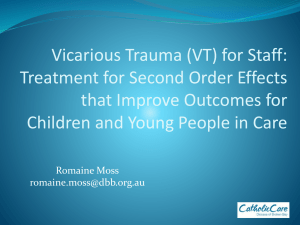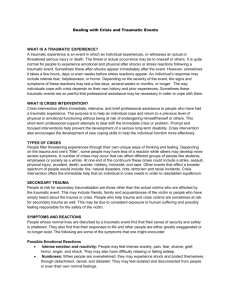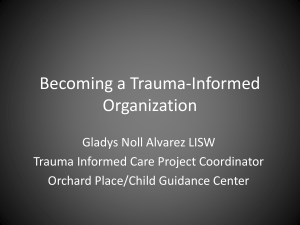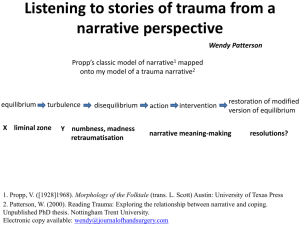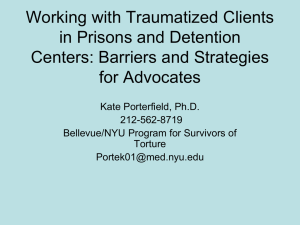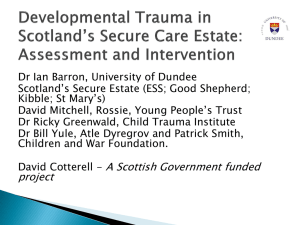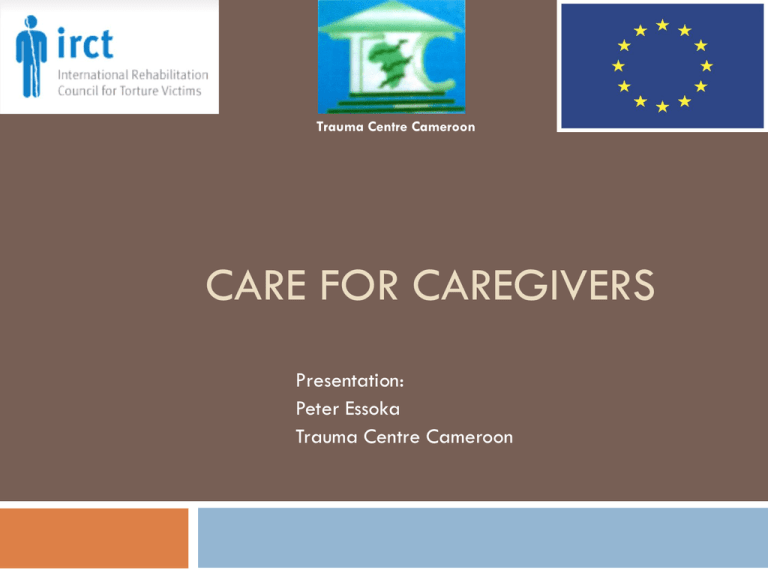
Trauma Centre Cameroon
CARE FOR CAREGIVERS
Presentation:
Peter Essoka
Trauma Centre Cameroon
Contamination:
"I love my work but lately I find
it contaminating my personal life.
I have nightmares about the
horrible things I hear about from
clients, my sex life has
deteriorated, I'm irritable and
distractible, I'm afraid for my
kids and tend to overprotect
them, and I don't trust anybody
anymore. I don't know what is
happening to me."
A Therapist
Empathy:
Double-Edged Sword
“Empathetic engagement helps workers meet the
needs of traumatized people…however, [it] has
also been associated with inducting traumatic
material from the primary victim (the client) to the
secondary victim (the worker).
Empathizing…helps the worker to understand the
client’s experience of being traumatized, but in the
process the worker may be traumatized as well.
These helpers might develop secondary or vicarious
traumatization or burnout… ”
Definitions
Vicarious or secondary traumatization (VT): harmful
changes in professionals’ views of themselves,
others, and the world as a result of exposure to
traumatic material
Secondary traumatic stress (STS): a syndrome among
professional helpers that mimics PTSD and occurs as
a result of exposure to the traumatic material
Definitions
Burnout:
Psychological exhaustion and diminished efficiency
resulting from overwork or prolonged exposure to
stress.
Burnout is a syndrome of emotional exhaustion,
depersonalisation,
and
reduced
personal
accomplishment that can occur among individuals
who work with people in some capacity.
Common Signs and Symptoms
Affective e.g., depressed mood, emotional
exhaustion…
Cognitive e.g., poor concentration, impaired
memory, intrusions…
Physical e.g., headaches, sleep disturbances, cardiovascular affections, eating disorders…
Behavioural e.g., poor work performance, frequent
anger outbursts, poor interpersonal relationships…
Motivational e.g., loss of interest and idealism
One core indicator is consistently identified –
exhaustion.
Common Characteristics
Cumulative.
Inevitable.
Developmental.
Modifiable.
Prevalence:
How Big is the Problem?
50% of workers suffered from high or very
high levels of trauma from helping others
(Conrad & Kellar-Geunthar, 2006)
37% of child protective workers experienced
clinical levels of emotional distress associated
with S.T.S. (Source: Meyers & Cornille, 2002).
The Stakes Are High…
If not addressed, [secondary trauma] may
adversely affect the caregivers’ work product and
interactions with clients. It may also negatively
impact caregivers’ emotional well-being and
relationships with their own families.
If not recognized and responded to, [secondary
trauma] may derail the primary mission of care
giving organisation--to identify and assist torture
and trauma survivors.
Barriers to Detection…Reasons Workers
May Not Acknowledge Secondary Trauma
Self-blame (It’s just me!)
Shame (I’m embarrassed to admit it)
Denial (It’ll pass if I ignore it!)
Self-sacrifice (Don’t want to bother co-workers)
Job Security (I can’t expose my weaknesses)
Pressure (I don’t have time to deal with it)
Cost (I can’t afford to take time off & spend money
for help)
Detection & Risk Factors
Personal Risk Factors
History of personal trauma
Personally identify with the victim
Negative personal circumstances (e.g., grief due to
recent loss)
Low levels of social support
Low levels of resilience (capacity of bouncing back)
Lack of meaningful personal relationships
Detection & Risk Factors
Work-Related Factors…
inexperience on the job
high caseload of trauma survivors (e.g., sexual
violence)
poor or no supervision
high frequency of exposure to traumatic material
exposure to critical incidents
Detection & Risk Factors
Organisational Factors…
Extraordinary high caseloads
High administrative burden
Difficult clients
Conflicts with co-workers or supervisors
Climate of pervasive, ongoing change
Excessive emphasis on efficiency, cost effectiveness and
competition.
Unforgiving environment. “If you can’t handle it, get
out!.”
1. What are your concerns
and experience?
2. What strategies can you
take at:
•
•
Individual level?
Organisational level?
Intervention and Prevention
Individual Level
increase self-awareness
identify reactions and symptoms
understand early warning signs
accurately name and articulate feelings
construct a fulfilling personal life outside work - regenerative & relaxing
activities, strong relationships, etc.
develop strong support networks (especially others who understand trauma
work)
acknowledge and process personal history of trauma
invoke humor
strive for realistic optimism
foster opportunities for spiritual growth and connection
recall importance of one’s work (i.e., your work does make a difference)
Intervention and Prevention
Supervisory Level
educate staff on hazards of secondary trauma
normalize responses to secondary trauma
promote ongoing self-assessment
schedule regular supervision meetings
utilize a relational, interactive model of supervision
promote other forms of supervision (e.g., peer, group meetings).
identify support resources for workers to access if needed
remind individuals of importance of their work
Intervention and Prevention
Organizational Climate
work-related stress is accepted as real and legitimate.
problem is owned by organization (not merely “problem”
workers).
secondary trauma responses are recognized as normal responses.
focus is on solutions (not blaming).
support and tolerance clearly expressed to worker.
other “climate” issues (caseloads, official policy, …)
Intervention and Prevention
Specific Organisational Actions…
in-service training
policy on secondary trauma
ongoing program to manage secondary trauma
regular supervision, consultation and support groups
professional development opportunities
rotation in caseload and job responsibility
health care plan with adequate health care coverage
You Make A Difference…
…but that difference is only possible
when you are healthy, functional, and
engaged. Caring for others is noble;
caring for yourself is required.
Author unknown




